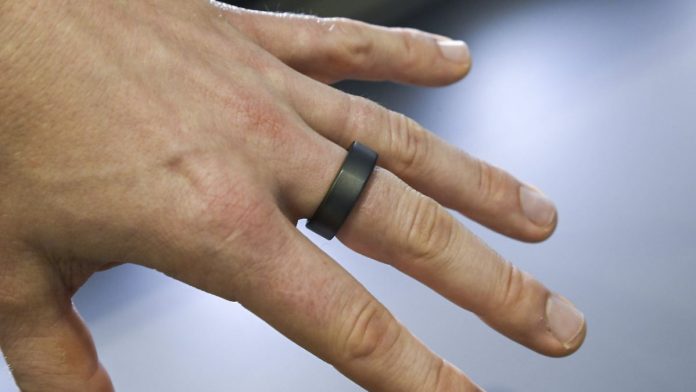Small ring, big effect
How smart rings can protect against heart attack and stroke
This audio version was artificially generated. More information | Send feedback
Health trackers in the form of rings 24/7 unobtrusively measure our sleep, the daily step or oxygen saturation in the blood. A university professor has researched the smart rings and explained when they even protect against fatal cardiovascular diseases.
Packed with fine sensors, Smart rings on the finger record a number of health data. Paid with a health app, they provide information about the sleep pattern, the activity level or even – depending on the model – about the individual stress level.
Smart rings that can capture the cardiac rate variability (HRV) provide valuable information about chronic stress. And it has a strong impact on heart health, as Prof. Olaf Hoos from the University of Würzburg has proven to be head of the sports center there.
That reveals the cardiac rate variability
The heart rate or cardiac rate variability can indicate whether the heartbeat reacts elastic when it is stressed or on the same (mostly fast) clock. A high variability shows good adaptability and stress resilience. With a low HRV, the risk of cardiovascular disease increases. If the HRV is tracked by a smart ring, this comes quite close to a permanent ECG. However, the values are not as precise as with an EKG in a medical laboratory.
In the NTV.de interview, Prof. Olaf Hoos explains how the smart rings work and what benefits they have to protect the heart and circulation.
ntv.de: What cardiovascular problems can the ring recognize?
Prof. Olaf Hoos: The system can now recognize an event quite well, which is perhaps inappropriate for the classic heart rhythm of the person. It cannot necessarily distinguish what that is exactly. But it can see: there is a problem.
How exactly does the HRV work?
The ring sits relatively narrowly on the finger and measures the volatile blood flow via the sensors, which is produced with every heartbeat. Similar to an EKG, the heart cycle depicts the repeating pulse shaft.
What experiences with smart rings did you have in research?
There is above all the Oura ring, the prototype of the smart ring. In my view, it is scientifically validated. It has also been developed several times. The optical sensors get better every day.
Which people do you recommend the smart ring?
I wouldn't moor it on a group of people. It is actually relevant for everyone.
Would my doctor take such an evaluation seriously?
Regulative function does not play a major role in classic training in medicine. But that has gotten a little better in recent years. In principle, it would work in such a way that you go to the doctor and say “There is something” and he would then write an EKG.
Does the app coupled with the ring give usable individual tips?
It depends on what you make of it. For you it is of course an assistance to experience: there is a lot of stress and I may not have felt that. In my view, it's about listening to your own body a little more. Because many have forgotten or may never have learned.
Smart Rings tested: a round thing?
So what can we derive from the measurement data?
Watch: How do I feel subjectively and how does it fit the data that such a ring has objectively measured. It is important to classify yourself. Especially when it comes to aging, where one or the other zipper and maybe cardiovascular problem can piling up. A smart ring is something that is helpful.
Prof. Olaf Hoos is involved in the IGAF association (International Society for Autonomous Functional Diagnostics and Regulation Medicine), which would like to make the analysis of the autonomous nervous system and the corresponding therapy options better known.
This is how our autonomous nervous system controls us
The autonomous nervous system is part of the nervous system and plays a crucial role in the regulation and control of the unconscious body functions. It is divided into two main areas: the likeable nervous system and the parasympathetic nervous system. Both systems work together to keep our body in a state of balance.
Sympathetic nervous system for top performance
The sympathetic nervous system is responsible for the “fighting or flight” reaction of the body. It prepares our body for stress or dangerous situations. When it is activated, it accelerates the heart rate, expands the bronchi (to increase oxygen intake), expand the pupils and slow down the digestion. It is almost the part of our nervous system that brings us to top performance.
Parasympathetic nervous system is important for relaxation
In contrast, the parasympathetic nervous system acts like a brake system. It is activated when we are in a safe, quiet environment. It slows down the heart rate, promotes digestion, relaxes the muscles and helps the body to store energy.
Although we cannot control the work of the autonomous nervous system directly, studies show that techniques such as meditation, deep breathing and regular movement have a positive impact on the system.


